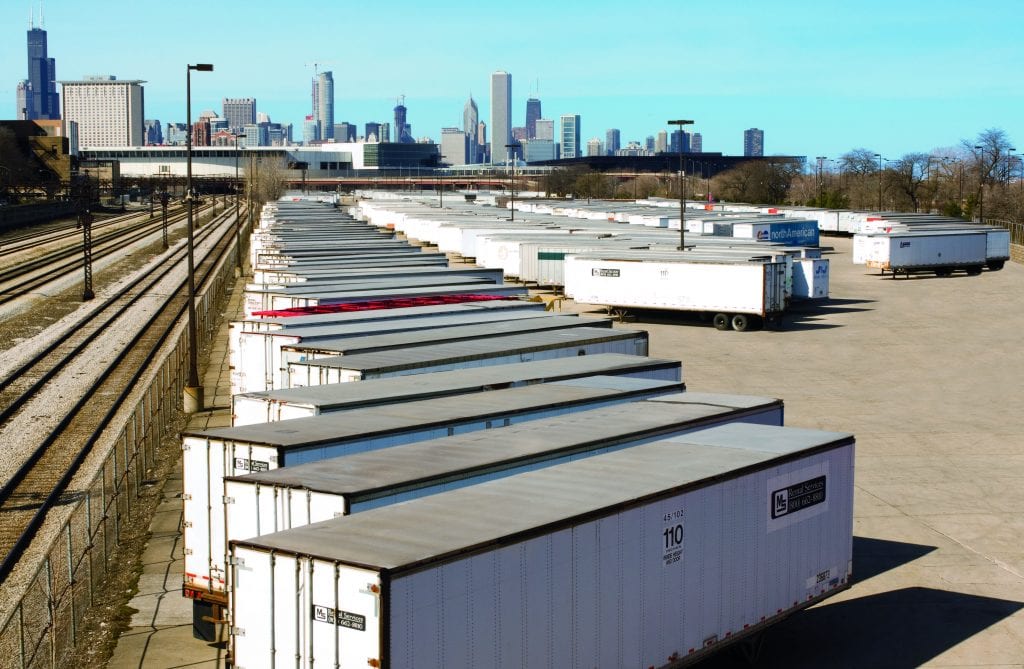…but this is harder to do without a marshalling yard
About 100 tradeshows and events annually take place across McCormick Place’s four buildings, which combined offer 2.6 million square feet of exhibition space. In 2014, Chicago hosted 24 of the largest U.S. tradeshows. The bigger the show becomes, the more the venue’s 562,500 square-foot marshalling yard becomes integral to smoother show operations.

Exhibitions often cause traffic congestion around venues. Additionally, trucks carrying exhibit freight could outnumber the docks a building provides.
To lessen the physical toll of tradeshows coming to Chicagoland while increasing the economic impact, McCormick Place — the largest convention center in North America — built its marshalling yard within close proximity.
Although the marshalling yard consists of 450 parking spaces, it has supported 650 trucks for Solar Power International, which has been handled by Shepard Exposition Services since 2004.
“The marshalling yard is a necessity for any tradeshow that cannot ensure adequate dock space for inbound and outbound freight deliveries when a driver arrives on site. Procedures are in place to expedite truck traffic in and out of the docks in a manner that ensures all exhibitor freight is unloaded and loaded with minimal congestion in and around the dock loading areas,” explained Roger Phillips, freight operations manager, Shepard Exposition Services.
Driving In
Of all the motorists sharing the road, large truck drivers have the most difficulty finding parking spaces. They are not allowed to pull over to the side of the road like most car drivers. The marshalling yard not only gives truck drivers a place to wait until freight can be unloaded by the venue’s labor, but it also gives them a chance to safely relax before they are contacted by the general services contractor’s (GSC) traffic personnel.
For the 2012 NATO Summit at McCormick Place, Hargrove checked in between 200-250 tractor-trailers. During the company’s most recent show at the venue for the National Science Teachers Association last March, Hargrove checked in more than 100 trucks.
“We prefer to call [drivers] on the phone. Drivers can wait around the marshalling yard or in the office,” commented Doug Sheaffer, senior freight manager, Hargrove.
Sheaffer added that some GSCs may choose to contact drivers differently, such as via text message. Shepard Exposition Services, on the other hand, also prefers to contact drivers by phone.
“When the driver checks in at the marshalling yard, they will give the marshalling yard personnel their cell phone number. The yard personnel will then issue the driver a number written on a window card and instruct the driver to put the card in his windshield and wait for a phone call to send them to the docks. If the driver cannot be reached by cell phone, a traffic person will walk the yard and locate the truck and give the driver instructions to go to the dock,” stated Phillips.
Operating Onsite
Larger exhibitions may cause the most logistical challenges. Therefore, they require careful organization in regards to move-in and move-out. The GSC carries the weight of this responsibility.
“The marshalling yard is a costly operational necessity for the general contractor due mostly to staffing requirements as well as additional equipment, such as computers, copiers, printers, etc. The general contractor must also rent building space and, in some venues, portable restrooms and dumpsters,” said Phillips.
GSCs that handle numerous shows at McCormick Place have permanent onsite offices, according to Sheaffer. For other GSCs, an onsite office comes along with their rental agreement.
Hargrove too brings in additional staff and equipment to support an event at McCormick Place. Each time Sheaffer is onsite, he said he is often impressed with the venue.
“The marshalling yard is in one spot. This is often not the case. You might have to go and rent an area somewhere [for other venues],” he explained. “No matter which building the show is in, this makes it easier.”
He added that with tradeshows simultaneously taking place across McCormick Place’s four buildings, drivers may get confused about which building’s docking area they should take the freight.
McCormick Place’s South Building, for example, has 65 docking spaces. Once there, freight is unloaded by the Teamsters.
“The general contractor has contracts with unions in mostly all convention cities. The Teamsters have jurisdiction at McCormick Place to unload freight under the supervision of the general contractor,” added Phillips.
Teamsters have unloaded millions of pounds of freight on behalf of GSCs. This has ranged from small packages to large crates or pad-wrapped material.
Moving In and Out
Show move-in and move-out dates are often specified in the GSC’s exhibitor services manual. These dates may be influenced by the size and type of show, according to Mary Kay Marquisos, senior director of communications at Metropolitan Pier and Exposition Authority, which owns McCormick Place.
“For example, a machine show could have two weeks where most shows will start on Monday and open on Saturday or Sunday,” stated Marquisos. “Trucks can park in [the] marshalling for up to five days prior to the first official move-in day. Target dates for check-in are assigned by the general contractor.”
Several factors help GSCs determine their show move-in and move-out dates:
Phillips explained that Shepard considers how many days and how much time per day is allotted to move freight in and out of the show, the number of large booths and how many truckloads of freight for each booth and how many dock spaces are available.
Hargrove, said Sheaffer, chooses its dates based on booth size and a booth’s location on the show floor.
Once these dates are communicated, the onsite move-in process starts.
“[Booths] farthest from the dock are unloaded first so that booths closer to the dock aren’t in the way of those further unloading,” Sheaffer said.
Shepard too follows a similar move-in process.
“We assign the largest booths farthest from the dock first and work ourselves out toward the docks,” stated Phillips. “This process is reversed on out bound, giving the larger booth more time to tear down while we are clearing the freight closest to the dock, which will clear the way to retrieve the larger shipments in the front of the show floor.”





























